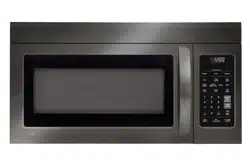Documents: Go to download!
User Manual
- User Manual - (English)
- Spec Sheet - (English)
- FEATURES
- USING YOUR MICROWAVE OVEN
- COOKING TIPS
- MAINTENANCE
- COOKING UTENSILS
- FAQS
- TROUBLESHOOTING
Table of contents
OWNER’S MANUAL MICROWAVE OVEN
FEATURES
MICROWAVE OVEN FEATURES
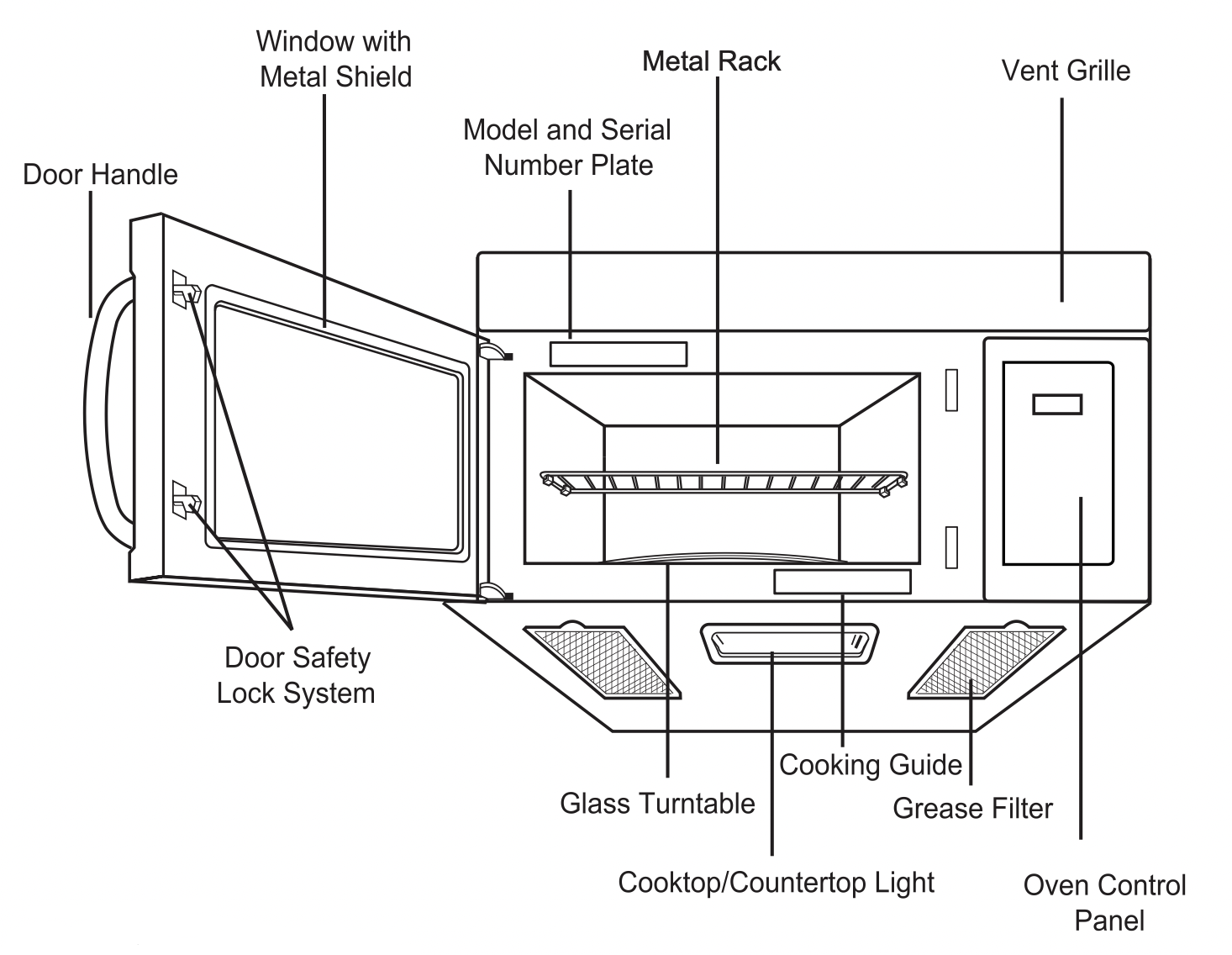
WARNING:
Do not operate the oven when empty or without the glass tray. It is best to leave a glass of water in the oven when not in use. The water will safely absorb all microwave energy, if the oven is accidentally started.
Your microwave oven is designed to make your cooking experience as enjoyable and productive as possible. To get you up and running quickly, the following is a list of the oven’s basic features:
- Metal Shielded Window. The shield prevents microwaves from escaping. It is designed as a screen to allow you to view food as it cooks.
- Model and Serial Number Plate & Cooking Guide Label
- Charcoal Filter (behind Vent Grille)
- Vent Grille
- Glass Tray. The glass tray moves food as it cooks for more even cooking.
It must be in the oven during operation for best cooking results. - Cooktop/Countertop Light
- Control Panel. Press the buttons on this panel to perform all functions.
- Metal Rack. Use for extra space when cooking in more than one container at the same time. Remove cooking rack when you are not using it.
- Grease Filter
OVEN CONTROL PANEL
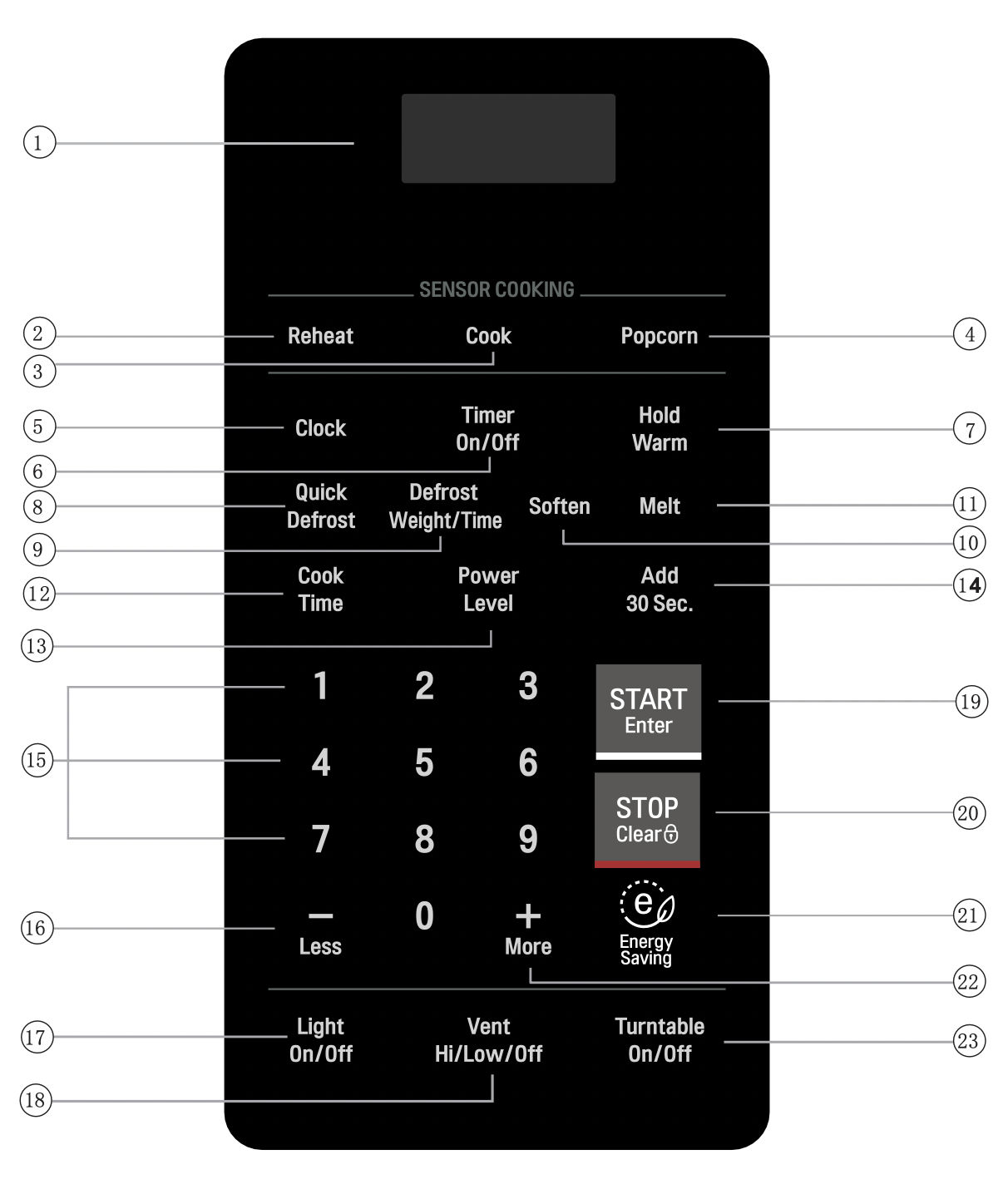
- Display. The Display includes a clock an indicators to tell you time of day, cooking time settings and cooking functions selected.
- Reheat. Press this button to reheat a casserole, dinner plate, and soup/sauce. The oven’s sensor will tell the oven how long to cook depending on the amount of humidity it detects from the food.
- Cook. Press this button to cook frozen lasagna, casseroles, and rice. The oven’s sensor will tell the oven how long to cook depending on the amount of humidity it detects from the food.
- Popcorn. Press this button when popping popcorn in your microwave oven. The oven’s sensor will tell the oven how long to cook depending on the amount of humidity it detects from the popcorn.
- Clock. Press this button to enter the time of day.
- Timer On/Off. Press this button to set the kitchen timer.
- Hold Warm. Press this button to keep hot, cooked foods warm in your microwave oven for up to 90 minutes.
- Quick Defrost. This button provides you with a rapid defrosting method for 1.0 pound frozen foods.
- Defrost Weight/Time. Press this button followed by number buttons to thaw frozen meat by weight.
- Soften. Press this button to soften butter, ice cream, cream cheese, frozen juice.
- Melt. Press this button to melt butter or margarine, chocolate, cheese, and marshmallows.
- Cook Time. Press this button to set a cooking time.
- Power Level. Press this button to select a cooking power level.
- Add 30 Sec. Press this button to add 30 seconds of cooking time each time you press it.
- Number. Press number buttons to enter cooking time, power level, quantities or weights.
- Less. Press this button to subtract ten seconds of cooking time each time you press it.
- Light On/Off. Press this button to turn the cooktop/countertop light on or off.
- Vent Hi/Low/Off. Press button to turn the vent on or off.
- START/Enter. Press this button to start a function. If you open the door after the oven begins to cook, press START/Enter again.
- STOP/Clear. Press this button to stop the oven or clear all entries.
- Energy Saving. Press this button to save energy.
- More. Press this button to add ten seconds of cooking time each time you press it.
- Turntable On/Off. Press this button to turn on/off the turntable. This option is not available in sensor cook, defrost, soften and melt modes.
USING YOUR MICROWAVE OVEN
LEARN ABOUT YOUR MICROWAVE OVEN
This section discusses the concepts behind microwave cooking and introduces you to the basics you need to know to operate your microwave oven. Please read this information before using your oven.
CAUTION
To avoid risk of personal injury or property damage, do not run the oven empty.
To avoid risk of personal injury or property damage, do not use stoneware, large sheets of aluminum foil, metal utensils, or metal trimmed utensils in the oven. Keep aluminum foil at least 1 inch from the oven wall, metal rack and other pieces of foil.
AUDIBLE SIGNALS
Audible signals are available to guide you when setting and using your oven:
- A beep will sound each time you press a button.
- 4 beeps signals the end of a cooking cycle.
INTERRUPTING COOKING
You can stop the oven during a cycle by opening the door. The oven stops heating and the fan stops, but the light stays on.
To restart cooking, close the door and press START/Enter.
If you do not want to continue cooking, open the door and press STOP/Clear.
CLOCK
When the oven is first plugged in or after a power failure, the display will show " : " . If a time of day is not set, " : " will show on the display until you press "Clock".
Example: To set the clock for 8:00 am
- Press Clock

- Enter the time by using the number buttons.

- Press START/Enter (or Clock)

NOTE: If PM does not appear in the display, the clock is seted to AM. To set the clock to PM, press Clock twice or until PM appears in the display. Then press START.
CHILD LOCK
Use this safety feature to lock the control panel when you are cleaning the oven, or so that children cannot use the oven unsupervised.
Example: To set the child lock.
- Press and hold STOP/Clear until you hear 2 beeps and "Loc" appears (approximately 4 seconds).

Example: To cancel the child lock.
- Press and hold STOP/Clear until "Loc" disappears (approximately 4 seconds).
See other models: LDP7708ST LDF5545ST LSWS306ST LSE4611ST LTG4715BM

COOKTOP LIGHT
The button on the bottom left of the control panel controls the cooktop light.
Example: To set the Lamp for ON
- Press Light On/Off.
To turn on, press once. "Light" will flash in display, then stay on.

- Press Light On/Off.

To turn off, press button again. "Light" will disappear from the display.
ENERGY SAVING
The Energy Saving feature saves energy by turning off the display by pressing the Energy Saving button. The display will automatically turn off after 5 minutes of idleness if the clock has not been set.
If the clock has been set,then the display will not automatically turn off.
- Press Energy Saving to turn the display off.

- Press Energy Saving to turn the display on.

TURNTABLE ON/OFF
For best cooking results, leave the turntable on.
It can be turned off for large dishes. Press Turntable On/Off button to turn the turntable on or off.
NOTES:
- This option is not available in sensor cook, defrost, soften and melt modes.
- Sometimes the turntable can become hot to touch. Be careful when touching the turntable during and after cooking.
- Do not run the oven when empty.
VENT HI/LOW/OFF
The vent removes steam and other vapors from the surface cooking area.
Press Vent once for High fan speed, twice for Low fan speed, or three times to turn the fan off.
- Press Vent Hi/Low/Off.

Press once. "Vent" will flash and "High" will show briefly in the display. - Press Vent Hi/Low/Off.

Press twice. "Vent" will flash and "Low" will appear briefly in the display. Press again and the fan will turn off. "Vent" will disappear from the display.
NOTE: Turn the microwave’s vent fan on whenever you use the oven range cooktop below it.The fan captures smoke, steam, and odors and also prevents the heat from the cooktop from damaging microwave components.
If the microwave is cooking, the vent fan turns on automatically if the sensors detect too much heat from the cooktop. This is normal, and is designed to prevent microwave component damage.
ADD 30 SEC
A time-saving button, this simplified control lets you quickly set and start microwave cooking without the need to press START/Enter.
Exaple: To set ADD 30 SEC for 2 minutes.
Press Add 30Sec. 4 times. The oven begins cooking and the display shows time counting down.

NOTE: If you press Add 30 Sec. , it will add 30 seconds up to 99 min 59 seconds.
COOKING AT HIGH COOK POWER
Example: To cook food for 8 minutes 30 seconds.
- Enter the cook time.

- Press START/Enter. When the cook time is over, you will hear four beeps and End will display.

MICROWAVE POWER LEVELS
This feature lets you program a specific cook time and power. For best results, there are 10 power level settings in addition to HIGH (100%) power . Refer to the “Cooking Guide for Lower Power Levels” on page 13 for more information. NOTE: If you do not select a power level, the oven will automatically cook at HIGH (100%) power.
Example: To cook for 5 minutes, 30 seconds at 80% power.
- Enter cook time.

- Press Power Level.

- Enter the power level.

- Press START/Enter. When the cook time is over, four beeps will sound and End will display.

MULTI-STAGE COOKING
For best results, some recipes call for different power levels during different stages of a cook cycle. You can program your oven to switch from one power to another for up to 2 stages. 3 stages can be programmed if the first stage is the defrost cycle.
Example: To cook food for 3 minutes at 100% power and then 70% power for 7 minutes 30 seconds.
- Enter the first cook time.

- Press Cook Time.

- Enter the second cook time.

- Press Power Level.

- Enter the power level.

- Press START/Enter.

When the cook time is over, four beeps will sound and End will display.
MORE / LESS
By using the More or Less buttons, all of the preprogrammed features like Cook can be adjusted to cook food for a longer or shorter time.
Pressing More will add 10 seconds to the cooking time each time you press it. Pressing Less will subtract 10 seconds from the cooking time each time you press it.
COOKING GUIDE FOR LOWER POWER LEVELS
The 10 power levels in addition to HIGH allow you to choose the best power level for the food you are cooking. Below are listed all the power levels, examples of foods best cooked at each level, and the amount of microwave power you are using.
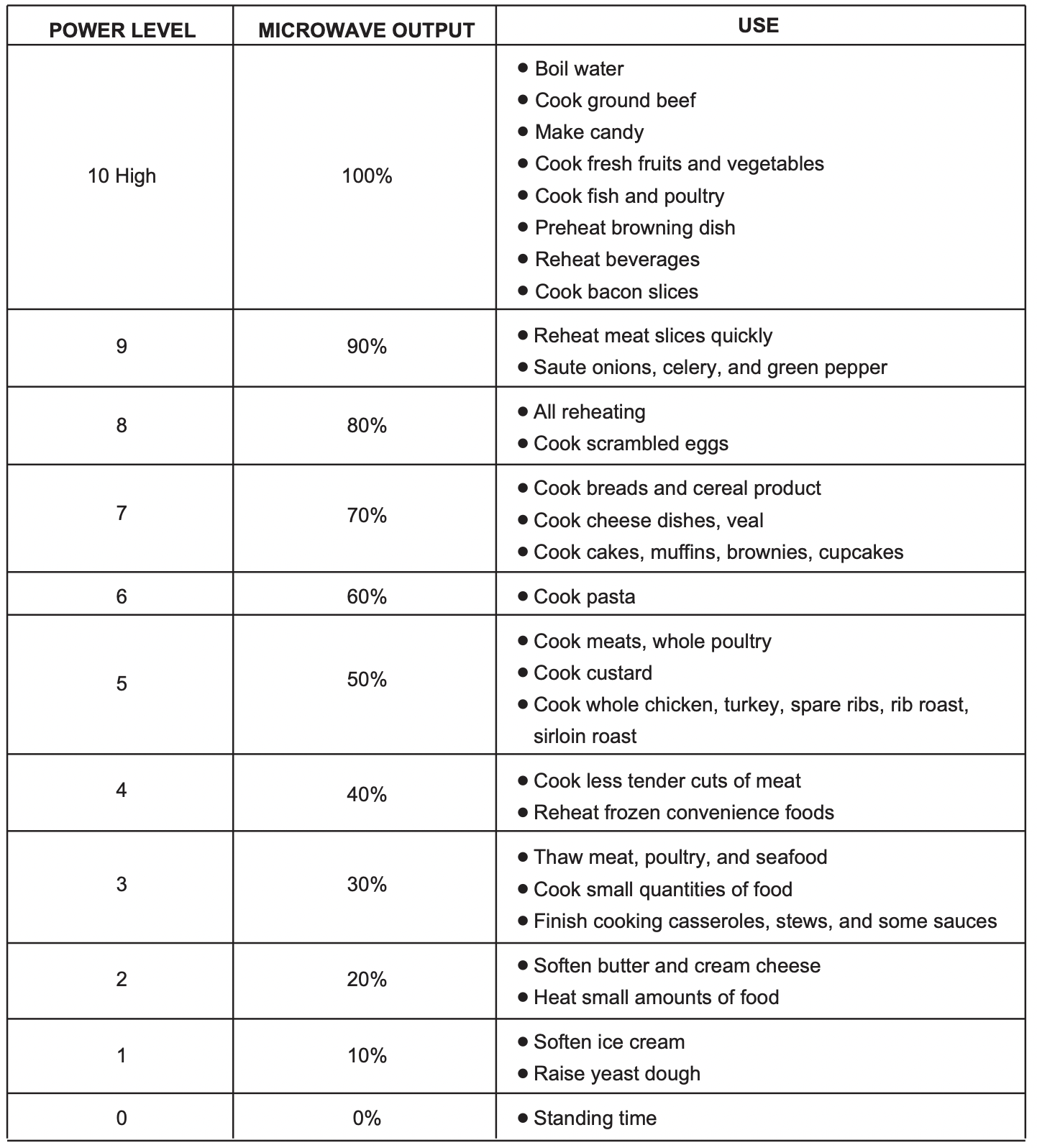
SENSOR OPERATING INSTRUCTIONS
Sensor Cook allows you to cook most of your favorite foods without selecting cooking times and power levels. The display will indicate the sensor category during the initial sensing period. The oven automatically determines the required cooking time for each food item.
When the internal sensor detects a certain amount of humidity coming from the food, it will tell the oven how much longer to heat. The display will show the remaining heating time. For best results when cooking by Sensor, follow these recommendations:
- Food cooked with the Sensor system should be at normal storage temperature.
- The glass tray and the outside of the container should be dry to assure best cooking results.
- Foods should always be covered loosely with microwavable plastic wrap, waxed paper, or a lid.
- Do not open the door or press STOP/Clear during the sensing time. When sensing time is over, the oven beeps twice and the remaining cooking time will appear in the display window. At this time you can open the door to stir, turn, or rearrange the food.
SENSOR COOKING GUIDE
Appropriate containers and coverings help to assure good Sensor cooking results.
- Always use microwavable containers and cover them with lids or vented plastic wrap.
- Never use tight-sealing plastic covers. They can prevent steam from escaping and cause food to overcook.
- Match the amount to the size of the container. Fill containers at least half full for best results.
- Be sure the outside of the cooking container and the inside of the microwave oven are dry before placing food in the oven. Beads of moisture turning into steam can mislead the sensor.
SENSOR POPCORN
Sensor Popcorn lets you pop 2.0, 3.0 and 3.5 ounce bags of commercially packaged microwave popcorn. Pop only one package at a time. If you are using a microwave popcorn popper, follow manufacturer’s instructions.
Example: To pop popcorn.
- Press Popcorn.

- Press START/Enter.
When the cook time is over, four beeps will sound and End will display.
- Recommended amounts: 2.0- 3.5 oz.
CAUTION
DO NOT leave the microwave oven unattended while popping corn.
When popping commercially packaged popcorn, remove the rack from the oven. Do not place the bag of microwave popcorn on the rack or under the rack.
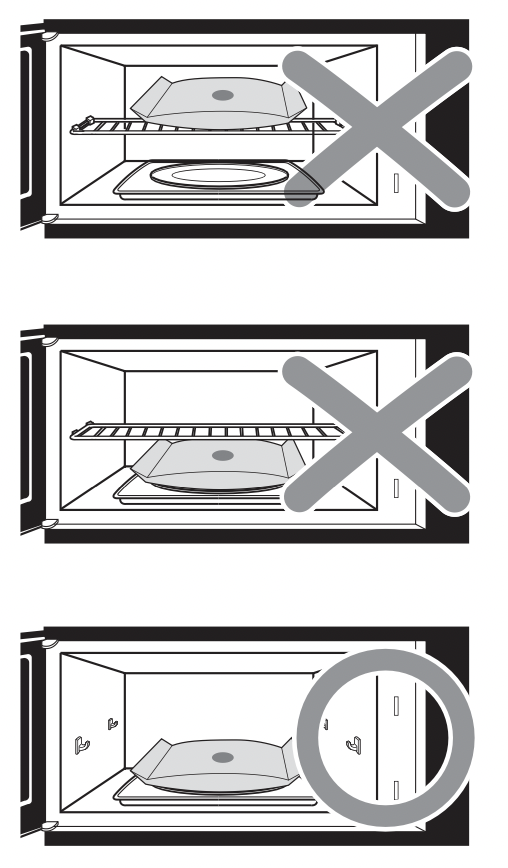
SENSOR REHEAT
Reheat lets you heat foods without needing to program times and Power Levels.
Reheat has preset Power Levels for 6 categories. See the details in the cooking guide table.
Example: To reheat a Casserole.
- Press Reheat.

- Press 3 to choose Casserole.

- Press START/Enter.

You can also press Reheat repeatedly to choose a food category (for example,press twice for soup). See Cooking Guide for Sensor Reheat table below for info. When the cook time is over, you will hear four beeps and End will display.
SENSOR COOK
Using Cook lets you heat common microwaveprepared foods without needing to program times and Cook Powers. Sensor Cook has preset Power Levels for 13 food categories. See the details in the cooking guide table.
Example: To cook Rice.
- Press Cook.

- Press 6 to choose Rice.

- Press START/Enter.

You can also press Cook repeatedly to choose a food category (for example, press six times for rice). See Cooking Guide for Sensor Cook on page 16. When the cook time is over, you will hear four beeps and End will display.
COOKING GUIDE FOR SENSOR REHEAT
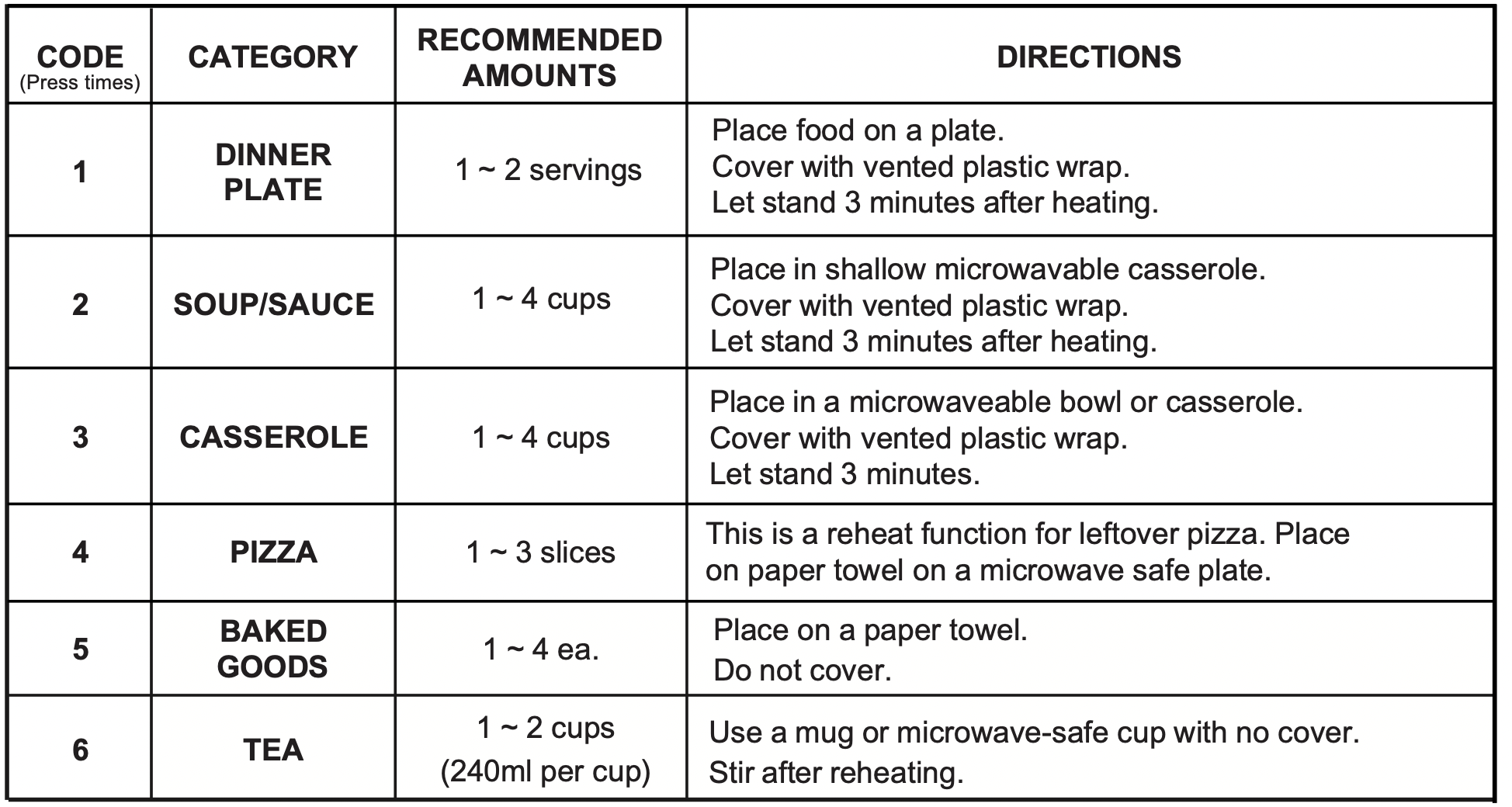
COOKING GUIDE FOR SENSOR POPCORN

COOKING GUIDE FOR SENSOR COOK
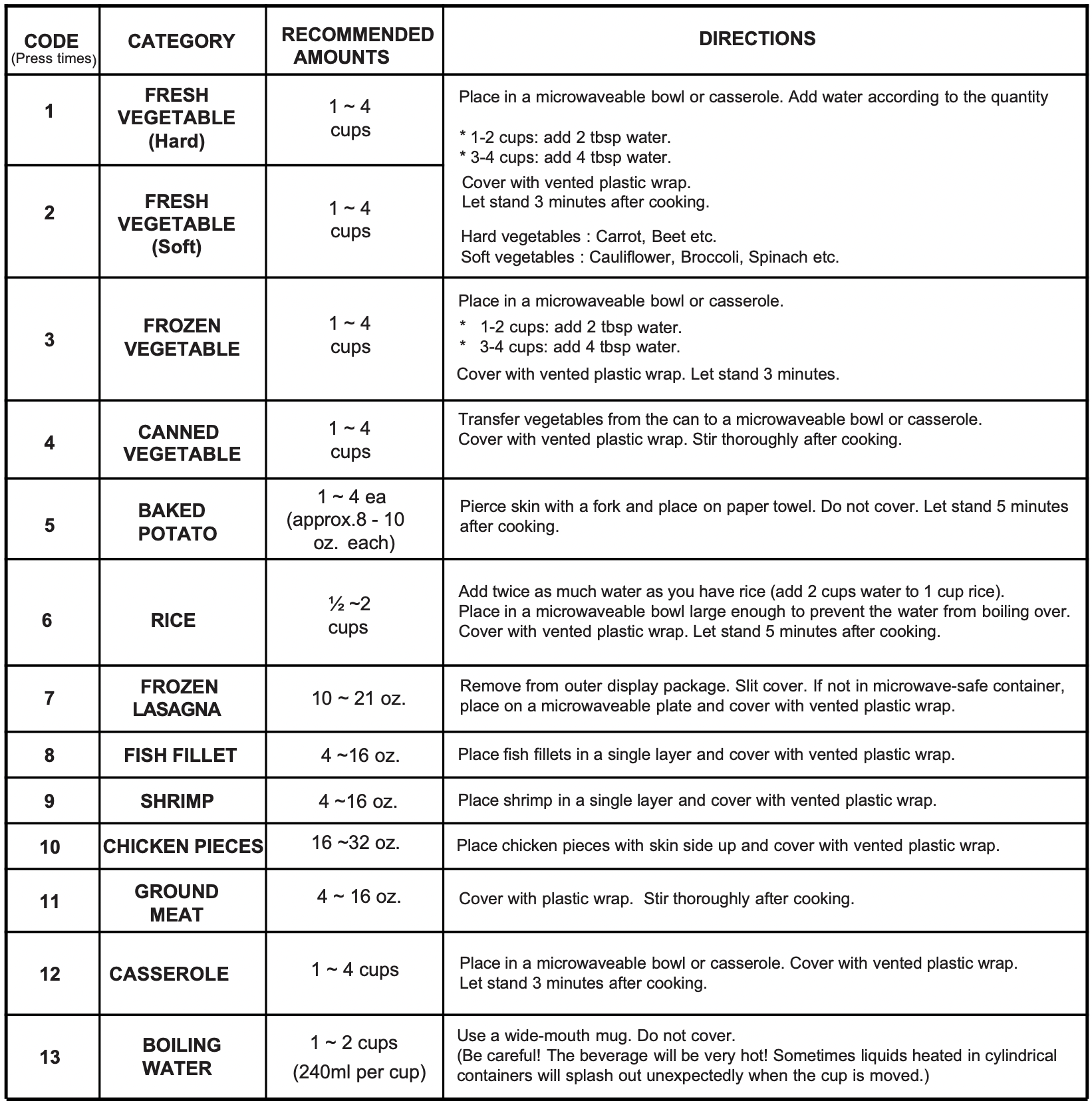
TIMER ON/OFF
You can use your microwave oven as a timer. Use the Timer for timing up to 99 minutes, 99 seconds.
Example: To count 3 minutes.
- Press Timer On/Off.

- Enter the time by using the number buttons.

- Press START/Enter. When the time is over, the oven will beep twice continuously until you press the Timer button.

NOTE: To turn off the Timer while it is still running, press the Timer button.
HOLD WARM
You can keep cooked food warm in your microwave oven for up to 90 minutes. You can use Hold Warm by itself or to follow a cooking cycle automatically.
Example: To use Hold Warm.
- Press Hold Warm

- Press START/Enter.

NOTES:
- Hold Warm operates for up to 90 minutes.
- Food cooked covered should be covered during Hold Warm.
- Pastry items (pies, turnovers, etc.) should be uncovered during Hold Warm.
- Complete meals kept warm on a dinner plate can be covered during Hold Warm .

To make Hold Warm automatically follow another cycle:
- While you are programming the cooking instructions, touch Hold Warm before pressing START/Enter.
- When the last cooking cycle is over, you will hear two beeps and Hold Warm will appear in the oven display.
- You can set Hold Warm to follow Auto Defrost, or multi-cycle cooking.
SOFTEN
The oven uses low power to soften foods (butter, ice cream, cream cheese, and frozen juice.) See the following table.
Example: To soften quart of ice cream.
- Press Soften twice to choose Ice Cream.

- Choose food amount.
Press 2 to choose quart.

- Press START/Enter.

SOFTEN TABLE
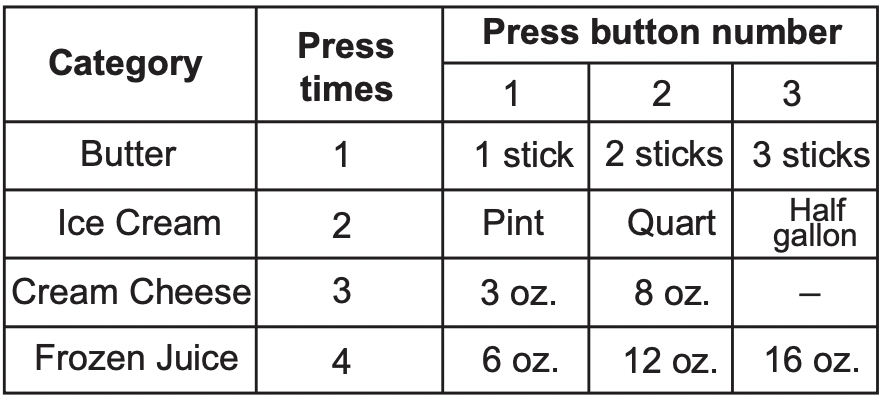
MELT
The oven uses low power to melt foods (butter or margarine, chocolate, marshmallows, or processed cheese food.) See the following table.
Example: To melt 8 oz. chocolate.
- Press Melt twice to choose Chocolate.

- Choose food amount. Press 2 to choose 8 oz.

- Press START/Enter.

MELT TABLE
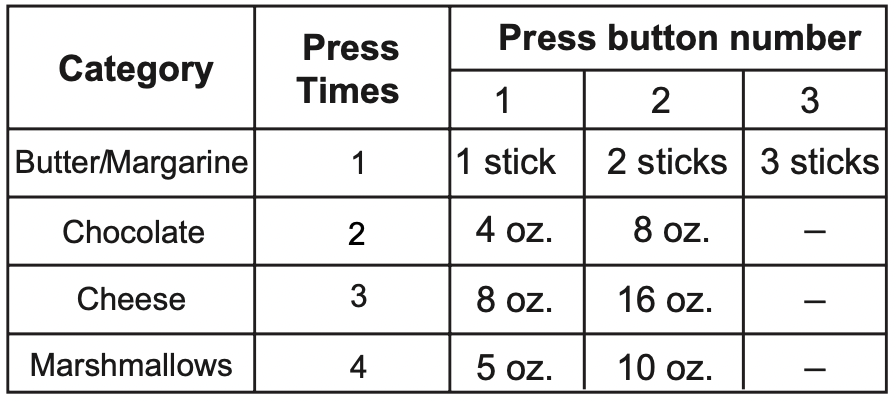
SOFTEN TABLE
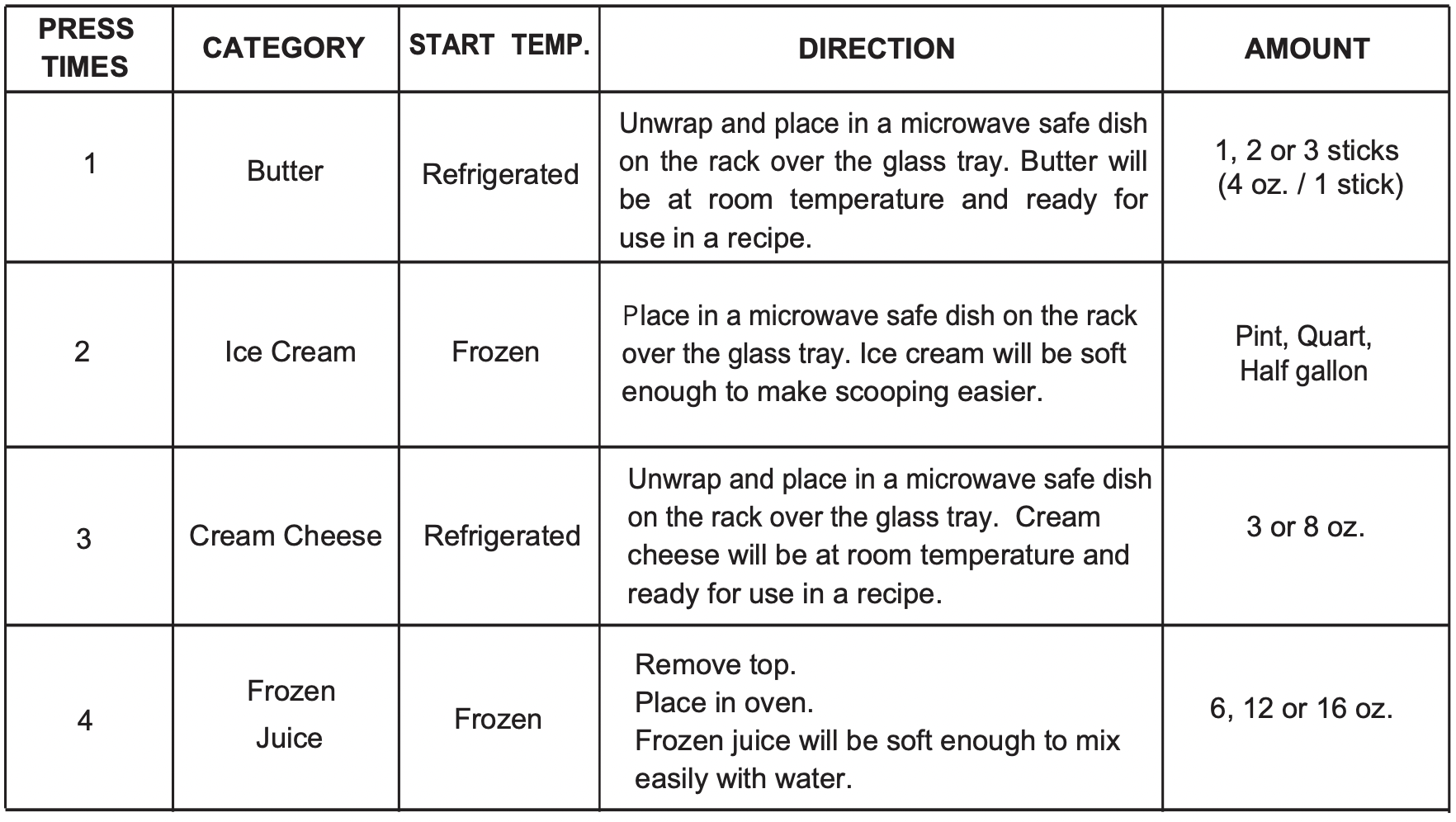
MELT TABLE
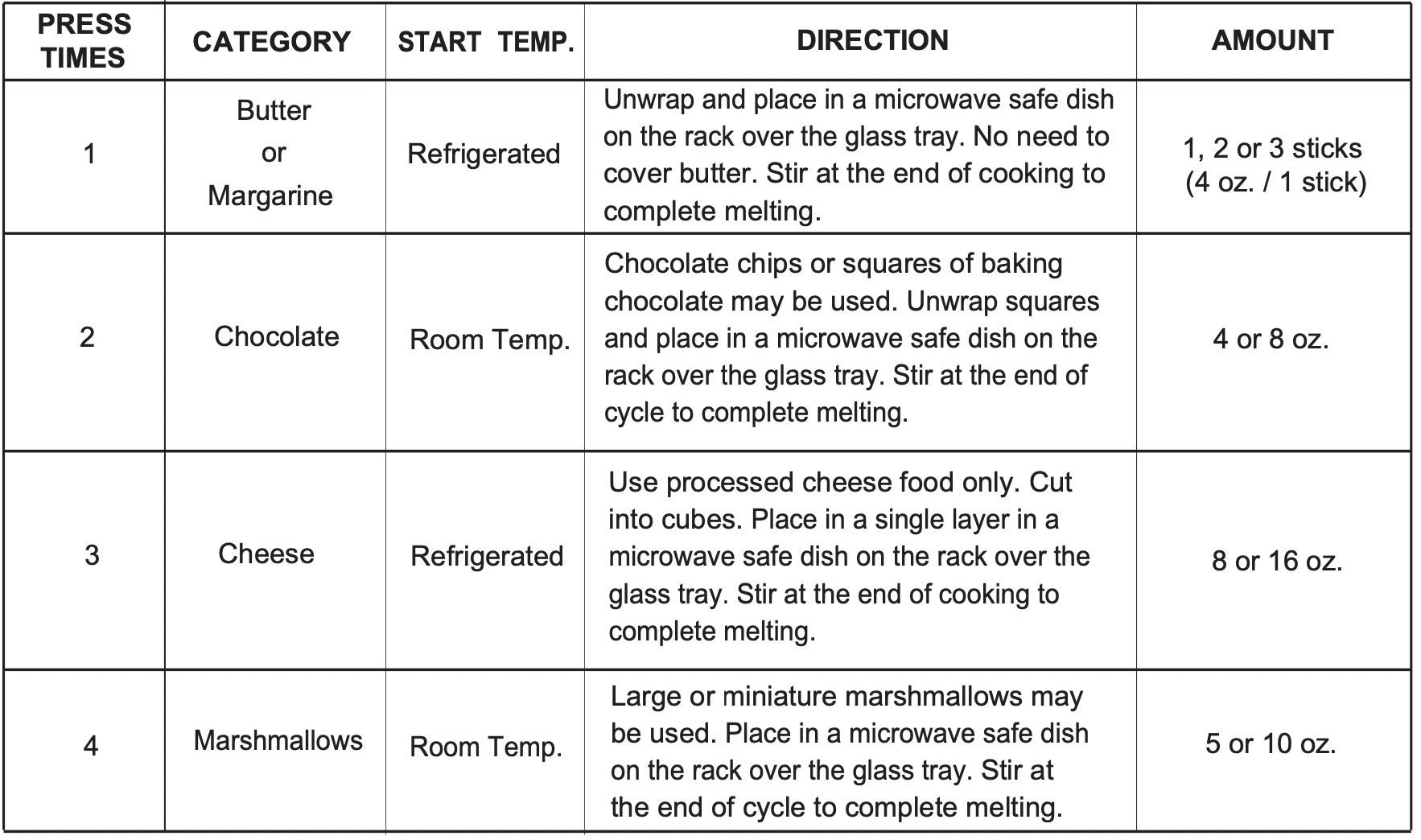
DEFROST WEIGHT / TIME
Five defrost choices are preset in the oven. The Defrost feature provides you with the best defrosting method for frozen foods, because the oven automatically sets the defrosting times for each food item according to the weight you enter. For added convenience, the Defrost feature includes a built-in tone mechanism that reminds you to check, turn over, separate, or rearrange the food during the defrost cycle. Four different defrosting presets are provided, plus the option to set your own defrost time.
- Meat
- Poultry
- Fish
- Bread
- Set Time
Press Defrost Weight/Time multiple times to select the category you want. Then enter weight. Available weight ranges for Meat, Poultry, and Fish are 0.1 to 6.0 lbs. The available weight range for Bread is 0.1 to 1.0 lb.
Example: To defrost 1.2 lbs. of meat.
- Press Defrost Weight/Time once to choose the Meat category.

- Enter the weight.

- Press START/Enter.

NOTE: After you press START/Enter, the display counts down the defrost time. The oven will beep once during the defrost cycle. At this time, open the door and turn, separate, or rearrange the food as needed. Remove any portions that have thawed, then return the frozen portions to the oven and press START/Enter to resume the defrost cycle. The oven will not stop following the beep unless the door is opened.
For best results:
- Remove fish, shellfish, meat, and poultry from its original closed paper or plastic package (wrapper). Otherwise, the wrap will hold steam and juice close to the foods, which can cause the outer surface of the foods to cook.
- Form the meat into the shape of a doughnut before freezing. When defrosting, scrape off thawed meat when the beep sounds and continue defrosting.
- Place foods in a shallow glass baking dish or a on a microwave roasting rack to catch drippings.
- Foods should still be somewhat icy in the center when removed from the oven.
DEFROST TABLE
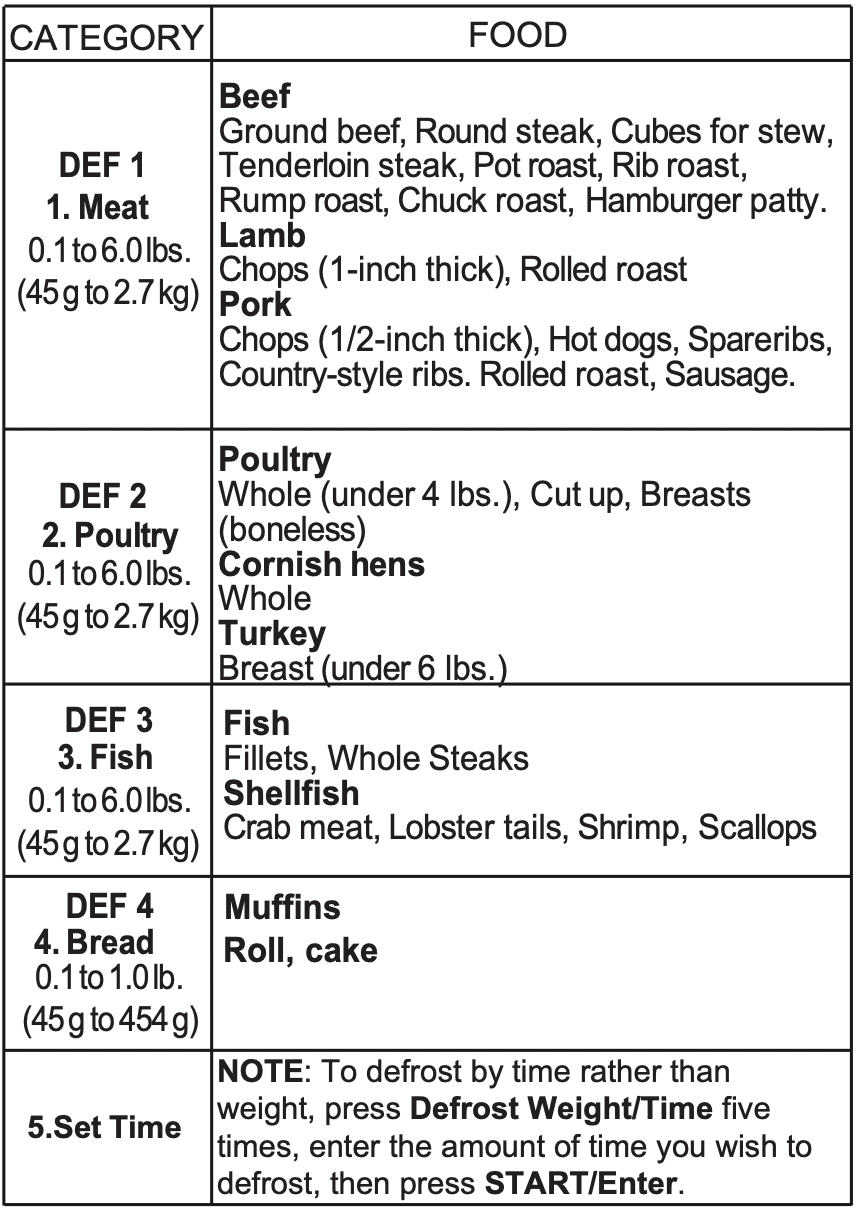
QUICK DEFROST
This is a quick defrost feature that allows you to choose a preset 2 minute defrost cycle at the touch of a button.
Example: To defrost for 2 minutes.
- Press Quick Defrost.
NOTE: The oven will start automatically.

- Halfway through the cycle, the oven will beep. Open the door, turn the meat over, Close the door, and press START/Enter to resume defrosting until the cycle ends.
When the defrost time is over, four beeps will sound and End will display.
DEFROSTING TIPS
- When using Defrost Weight/Time, the weight to be entered is the net weight in pounds and tenths of pounds (the weight of the food minus the container).
- Before starting, make sure you have removed any of the metal twist-ties which often come with frozen food bags, and replace them with strings or elastic bands.
- Open containers such as cartons before they are placed in the oven.
- Always slit or pierce plastic pouches or packaging.
- If food is foil wrapped, remove foil and place food in a suitable container.
- Slit the skins, if any, of frozen food such as sausage.
- Bend plastic pouches of food to ensure even defrosting.
- Always underestimate defrosting time. If defrosted food is still icy in the center, return it to the microwave oven for more defrosting.
- The length of defrosting time varies according to how solidly the food is frozen.
- The shape of the package affects how quickly food will defrost. Shallow packages will defrost more quickly than a deep block.
- As food begins to defrost, separate the pieces. Separated pieces defrost more easily.
- Use small pieces of aluminum foil to shield parts of food such as chicken wings, leg tips, fish tails, or areas that start to get warm. Make sure the foil does not touch the sides, top, or bottom of the oven. The foil can damage the oven lining.
- For better results, let food stand after defrosting. (For more information on standing time, see the “Microwave Cooking Tips” section.)
- Turn food over during defrosting or standing time. Break apart and remove food as rquired.
METAL RACK
CAUTION
- To avoid risk of property damage:
- Do not use the rack to pop popcorn.
- The rack must be on the four plastic supports when used.
- Use the rack only when cooking food on the rack position.
- Do not cook with the rack on the floor of the oven.
The metal rack gives you extra space when cooking in more than one container at the same time.
To use the rack:
- Place the rack securely in the four plastic supports.
The rack MUST NOT touch the metal walls or back of the microwave oven. - Place equal amounts of food both ABOVE AND BELOW the rack.
The amount of food must be approximately the same to balance out the cooking energy.
COOKING TIPS
GETTING THE BEST COOKING RESULTS
To get the best results from your microwave oven, read and follow the guidelines below.
- Storage Temperature: Foods taken from the freezer or refrigerator take longer to cook than the same foods at room temperature. The time for recipes in this book is based on the normal storage temperature of the food.
- Size: Small pieces of food cook faster than large ones, pieces similar in size and shape cook more evenly. For even cooking, reduce the power when cooking large pieces of food.
- Natural Moisture: Very moist foods cook more evenly because microwave energy is attracted to water molecules.
- Stir foods such as casseroles and vegetables from the outside to the center to distribute the heat evenly and speed cooking. Constant stirring is not necessary.
- Turn over foods like pork chops, baking potatoes, roasts, or whole cauliflower halfway through the cooking time to expose all sides equally to microwave energy.
- Place delicate areas of foods, such as asparagus tips, toward the center of the dish.
- Arrange unevenly shaped foods, such as chicken pieces or salmon steaks, with the thicker, meatier parts toward the outside of the dish.
- Shield,with small pieces of aluminum foil, parts of food that may cook quickly, such as wing tips and leg ends of poultry.
- Let It Stand: After you remove the food from the microwave, cover the food with foil or a casserole lid and let it stand to finish cooking in the center and avoid overcooking the outer edges. The length of standing time depends on the density and surface area of the food.
- Wrapping in waxed paper or paper towel: Sandwiches and many other foods containing prebaked bread should be wrapped prior to microwaving to prevent them from drying out.
FISH & SHELLFISH
Cooking Fish and Shellfish: General Directions
- Prepare the fish for cooking.
- Completely defrost the fish or shellfish.
- Arrange unevenly shaped pieces with thicker parts toward the outside of the dish. Arrange shellfish in a single layer for even cooking.
- The type of cover you use depends on how you cook. Poached fish needs a microwavable lid or vented plastic wrap.
- Baked fish, coated fish, or fish in sauce needs to be covered lightly with waxed paper to keep the coating crisp and the sauce from getting watery.
- Always set the shortest cooking time. Fish is done when it turns opaque and the thickest part begins to flake. Shellfish is done when the shell turns from pink to red and the flesh is opaque and firm.
- The Fish and Shellfish Cooking Table below provides specific directions with Power Level and Cooking Time settings for most types of fish and shellfish.
FISH AND SHELLFISH COOKING TABLE

APPETIZERS/SAUCES/SOUPS
Cooking Appetizers: Tips and Techniques
Recommended
- Crisp crackers, such as melba toast, shredded wheat and crisp rye crackers are best for microwave use. Wait until party time to add the spreads. Place a paper towel under the crackers while they cook in the microwave oven to absorb extra moisture.
- Arrange individual appetizers in a circle for even cooking.
- Stir dips to distribute heat and shorten cooking time.
Cooking Sauces: Tips and Techniques
- Use a microwavable casserole or glass measuring cup that is at least two or three times the volume of the sauce.
- Sauces made with cornstarch thicken more rapidly than those made with flour.
- Cook sauces made with cornstarch or flour uncovered so you may stir them two or three times during cooking for a smooth consistency.
- To adapt a conventional sauce or gravy recipe, reduce the amount of liquid slightly.
Cooking Soups: Tips and Techniques
- Cook soups in a microwavable dish which holds double the volume of the recipe ingredients to prevent boil-over, especially if you use cream or milk in the soup.
- Generally, cover microwaved soups with VENTED plastic wrap or a microwavable lid.
- Cover foods to retain moisture. Uncover foods to retain crispness.
- Avoid overcooking by using the minimum suggested time. Add more time, if necessary, only after checking the food.
- Stirring occasionally will help blend flavors, distribute heat evenly, and may even shorten the cooking time.
- When converting a conventional soup recipe to cook in the microwave, reduce the liquid, salt, and strong seasonings.
Not Recommended
- Appetizers with a crisp coating or puff pastry are best done in a conventional oven with dry heat.
- Breaded products can be warmed in the microwave oven but will not come out crisp.
MEAT
Cooking Meat: General Directions
- Prepare the meat for cooking.
- Defrost completely.
- Trim off excess fat to avoid splattering.
- Place the meat, fat side down, on a microwavable rack in a microwavable dish.
- Use oven cooking bag for less tender cuts of meat.
- Arrange the meat so that thicker portions are toward the outside of the dish.
- Cover the meat with waxed paper to prevent splattering.
- Tend the meat as it cooks.
- Drain juices as they accumulate to reduce splattering and keep from overcooking the bottom of the meat.
- Shield thin or bony portions with strips of foil to prevent overcooking.
NOTE: Keep the foil at least 1 inch from the oven walls, and do not cover more than one-third of the meat with foil at any one time.
- Let the meat stand covered with foil 10-15 minutes after you remove it from the oven. The internal temperature of the meat may rise from 5-10°F during standing time.
The Meat Cooking Table on the next page provides detailed directions, Power Level, and Cooking Time settings for most cuts of meat.
MEAT COOKING TABLE
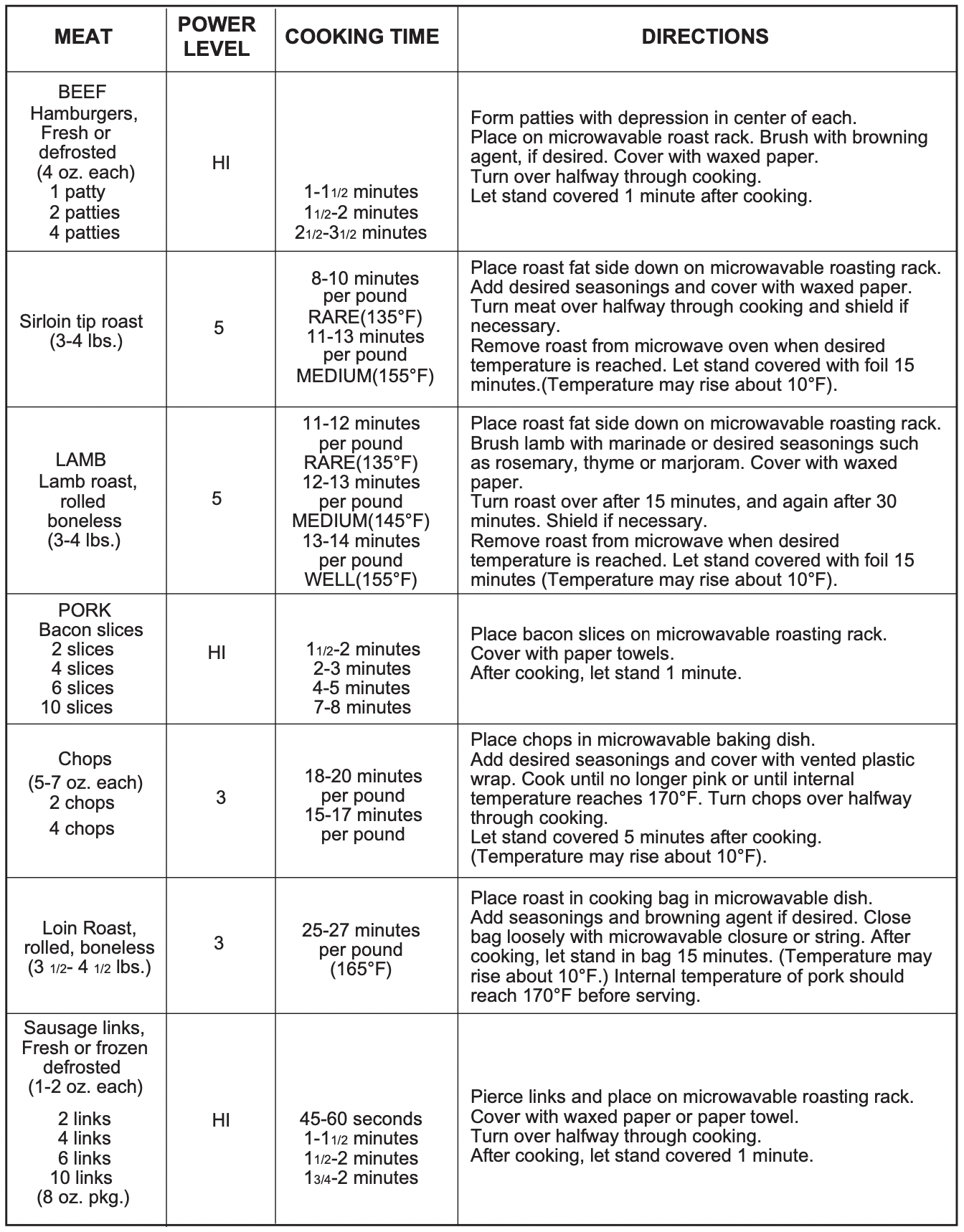
POULTRY
Cooking Poultry: General Directions
- Prepare the poultry for cooking.
- Defrost completely.
- Arrange poultry pieces with thicker pieces at the outside edge of the baking dish. When cooking legs, arrange them like the spokes of a wheel.
- Cover the baking dish with waxed paper to reduce splattering.
- Use a browning agent or cook with a sauce to give a browned appearance.
- Tend the poultry as it cooks.
- Drain and discard juices as they accumulate.
- Shield thin or bony pieces with small strips of aluminum foil to prevent overcooking. Keep foil at least 1 inch from the oven walls and other pieces of foil.
- The poultry is done when it is no longer pink and the juices run clear. When done, the temperature in the thigh meat should be 180-185°F.
- Let the poultry stand covered with foil after cooking for 10 minutes.
The Poultry Cooking Table below provides detailed directions, Power Level, and Cooking Time settings for most cuts and types of poultry.
POULTRY COOKING TABLE
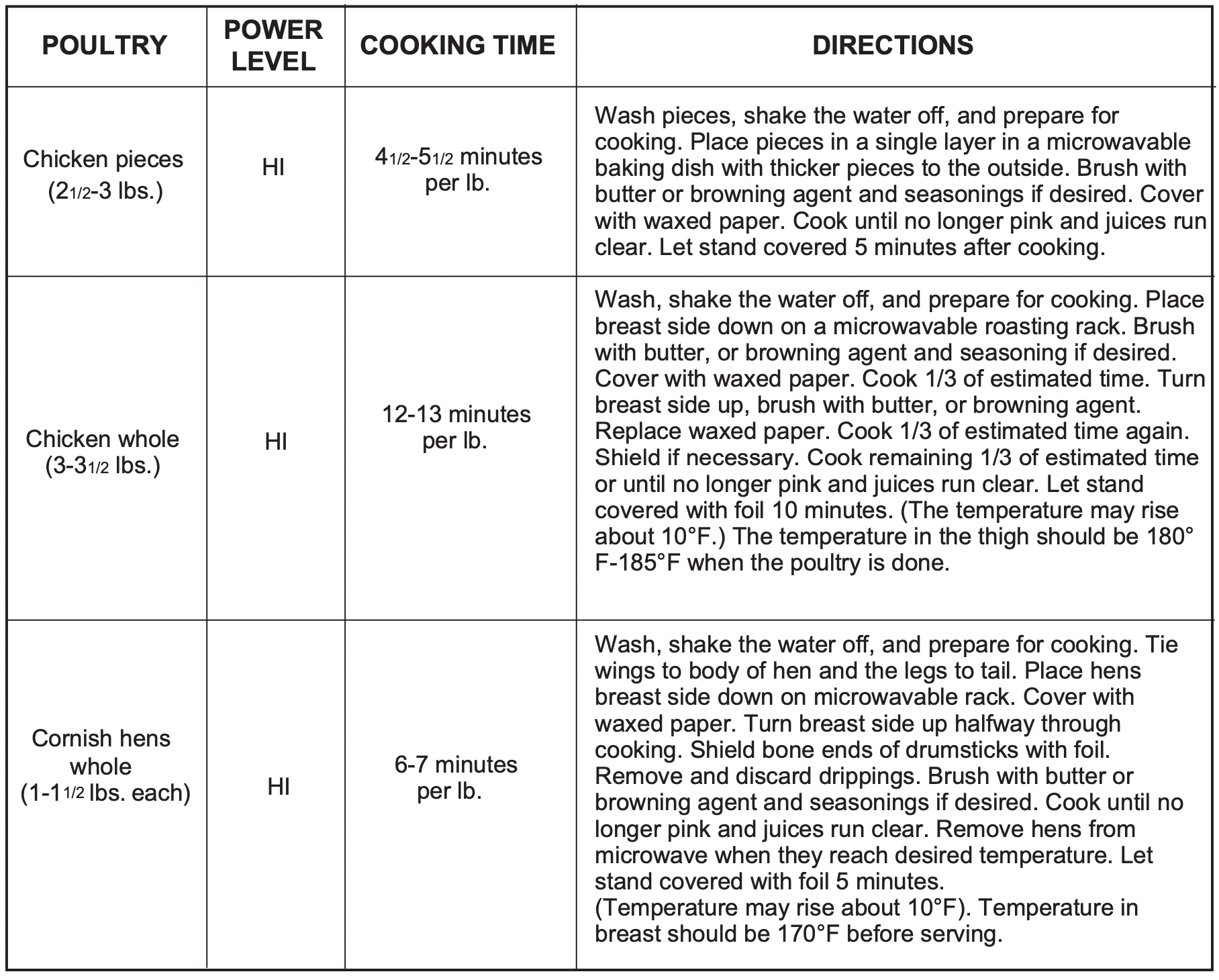
PASTA AND RICE
Microwave cooking and conventional cooking of pasta, rice, and cereal require about the same amount of time, but the microwave is a more convenient method because you can cook and serve in the same dish.
There is no stirring needed and leftover pasta tastes just like fresh cooked when reheated in the microwave oven.
Cooking Pasta and Rice: Tips and Techniques
- If you are planning to use rice or pasta in a casserole, undercook it so it is still firm.
- Allow for standing time with rice, but not for pasta.
- The Pasta and Rice Cooking Tables below provide specific directions, with Power Level and Cooking Time settings for most common types of pasta and rice.
PASTA COOKING TABLE
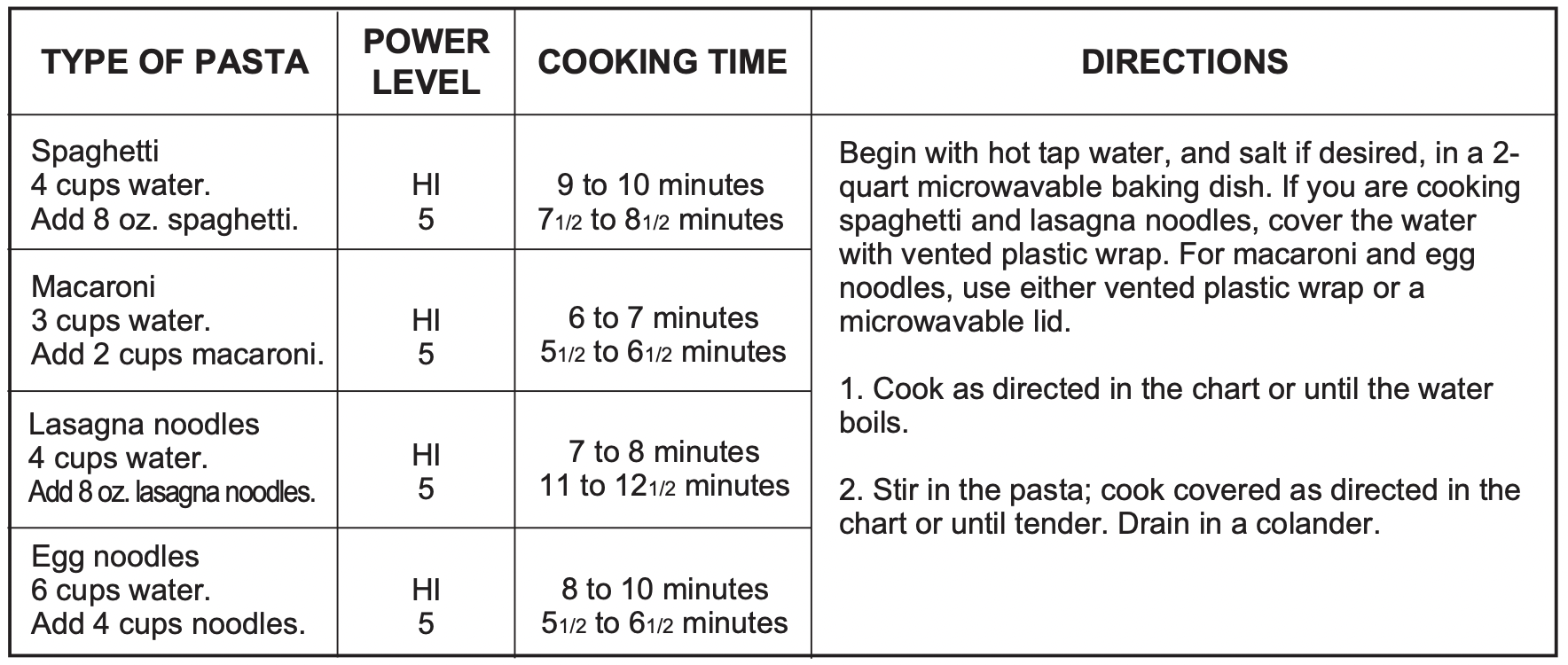
RICE COOKING TABLE
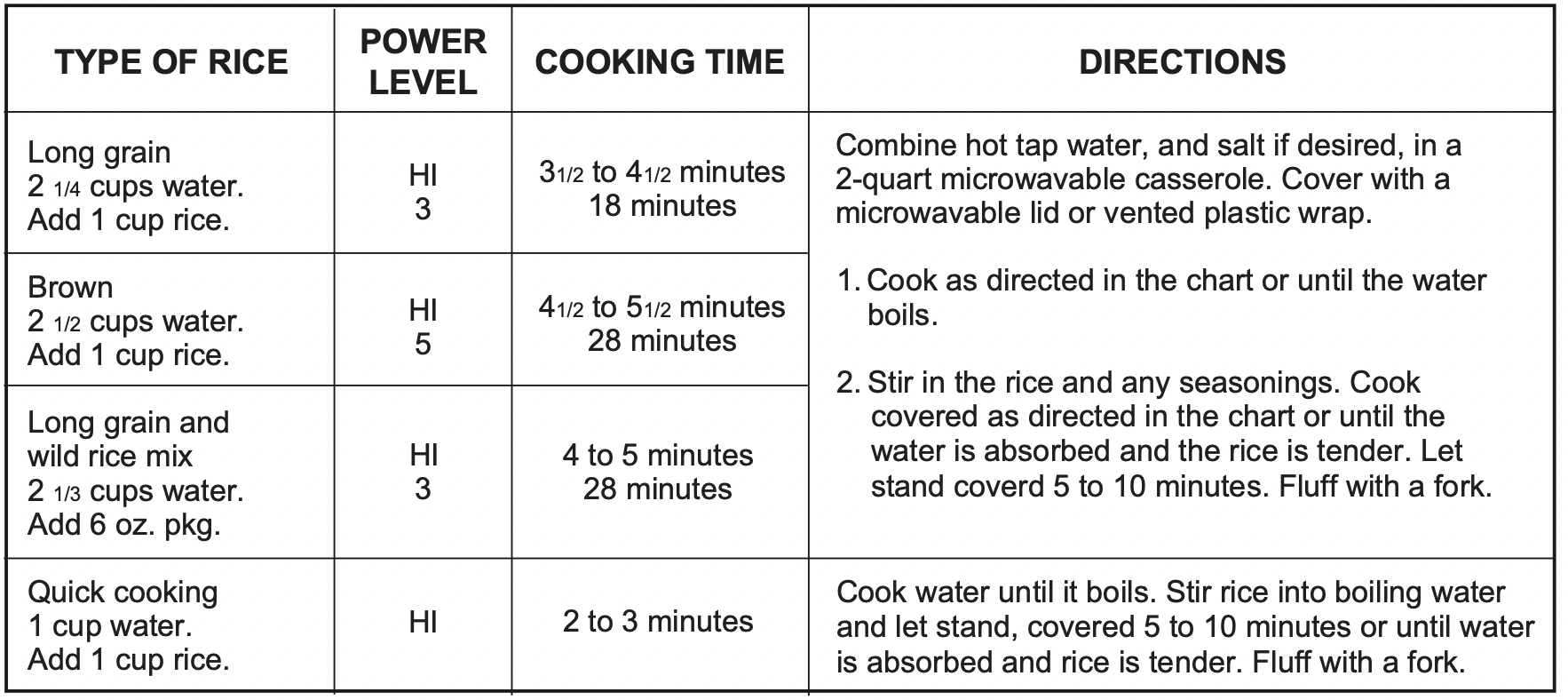
MAINTENANCE
CARE AND CLEANING
For best performance and safety, keep the oven clean inside and outside. Take special care to keep the inner door panel and the oven front frame free of food or grease build-up.
Never use abrasive powder or pads. Wipe the microwave oven inside and out, including the hood bottom cover, with a soft cloth and a warm (not hot) mild detergent solution. Then rinse and wipe dry.
Use a chrome cleaner and polish on chrome, metal and aluminum surfaces. Wipe spatters immediately with a wet paper towel, especially after cooking chicken or bacon. Clean your oven weekly or more often, if needed.
METAL RACK
Wash the metal rack with a mild soap and a soft or nylon scrub brush.Dry completely.
Do not use abrasive scrubbers or cleaners to clean rack.
CLEANING THE GREASE FILTERS
The grease filters should be removed and cleaned often, at least once a month.
- To remove the grease filters, slide each filter to the side, then pull the filters downward. The filters will drop out.

- Soak grease filters in hot water and a mild detergent. Rinse well and shake to dry. Do not use ammonia or place them in a dishwasher. The aluminum will darken.
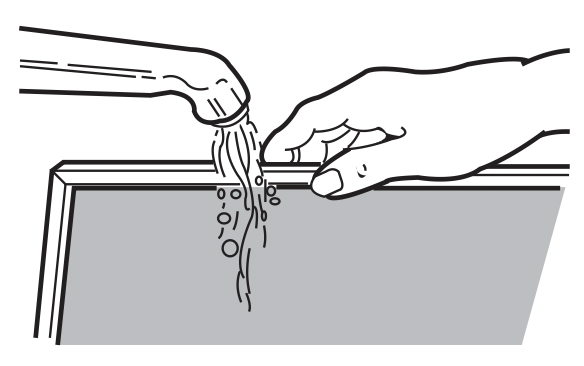
- To reinstall the filters, slide them into the side slots, then push up and forward to lock.
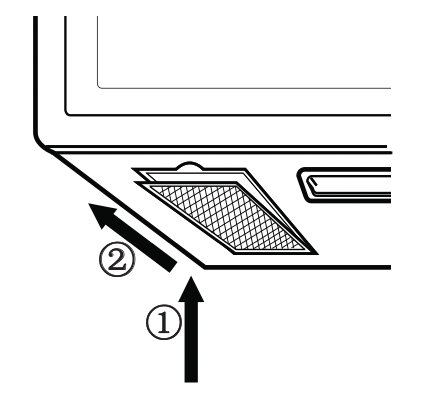
NOTE: Do not operate the hood without the filters in place.
CHARCOAL FILTER REPLACEMENT
If your oven is vented inside, the charcoal filter should be replaced every 6 to 12 months, and more often if necessary. The charcoal filter cannot be cleaned.
- Turn the power off at the main power supply and wear gloves
- Remove the two vent grille mounting screws. (2 outside screws)
- Tip the grille forward, then lift it out.
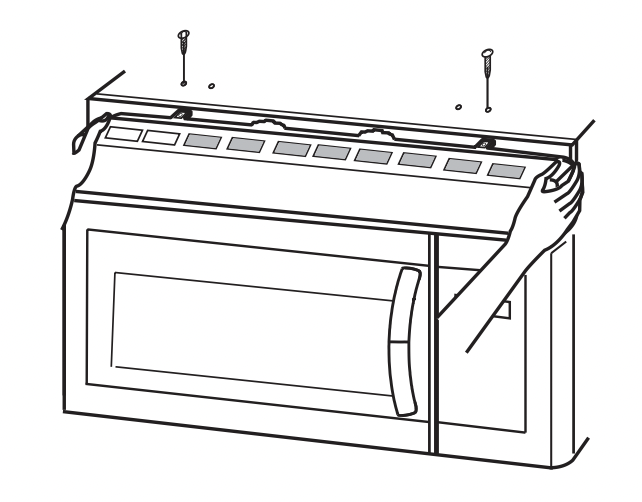
- Open the door.
- Remove the old filter.
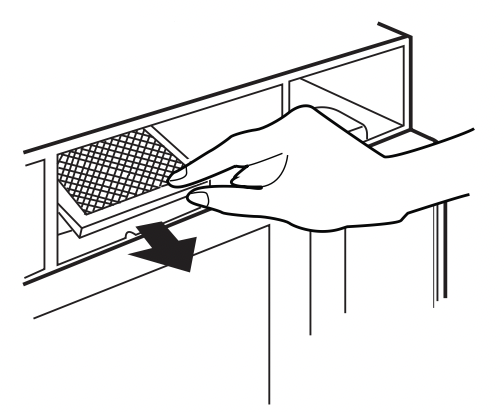
- Slide a new charcoal filter into place and close the door. The filter should rest at the angle shown.
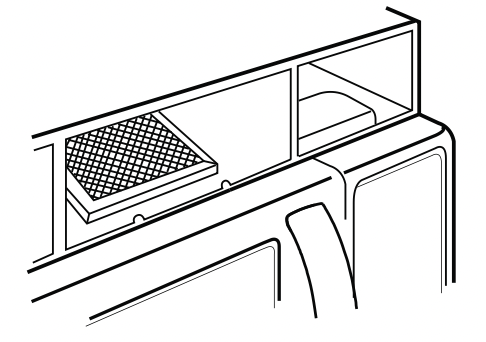
- Slide the bottom of the vent cover into place. Push the top until it snaps into place. Replace the mounting screws. Turn the power back on at the main power supply and set the clock.
COOKTOP/NIGHT LIGHT REPLACEMENT
- Unplug the oven or turn off power at the main power supply.
- Remove the bulb cover mounting screws.
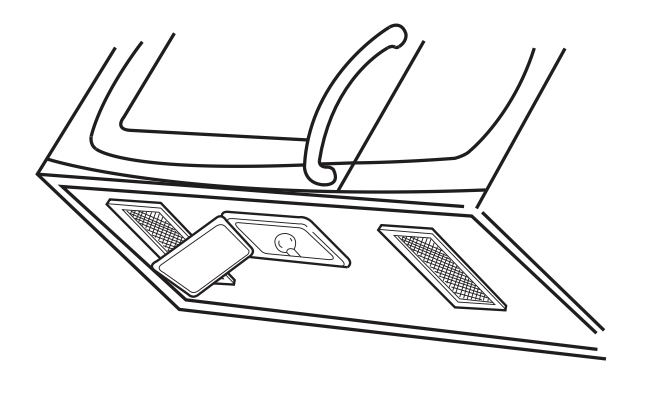
- Replace the bulb with a 30 watt appliance bulb.
- Replace the bulb cover and mounting screws.
- Turn the power back on at the main power supply.
OVEN LIGHT REPLACEMENT
- Unplug the oven or turn off power at the main power supply and wear gloves.
- Remove the vent cover mounting screws.
(2 outside screws) - Tip the cover forward, then lift out to remove.
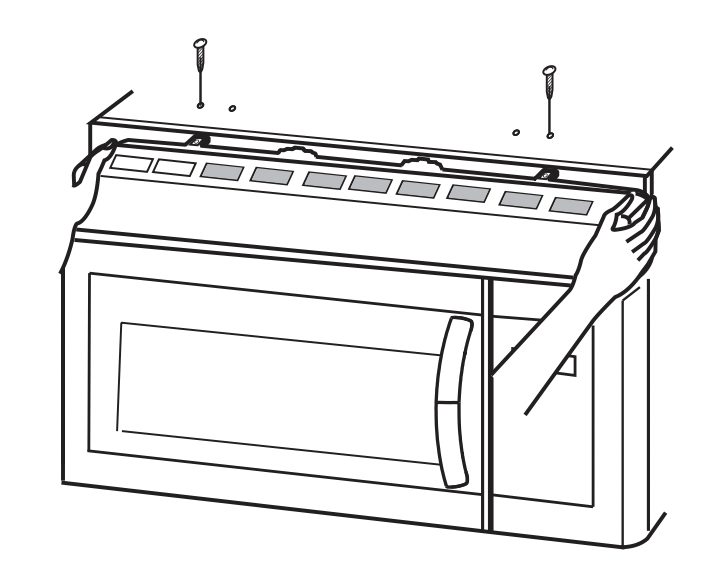
- Remove the cover screw,pull the cover forward and then lift up the bulb holder.
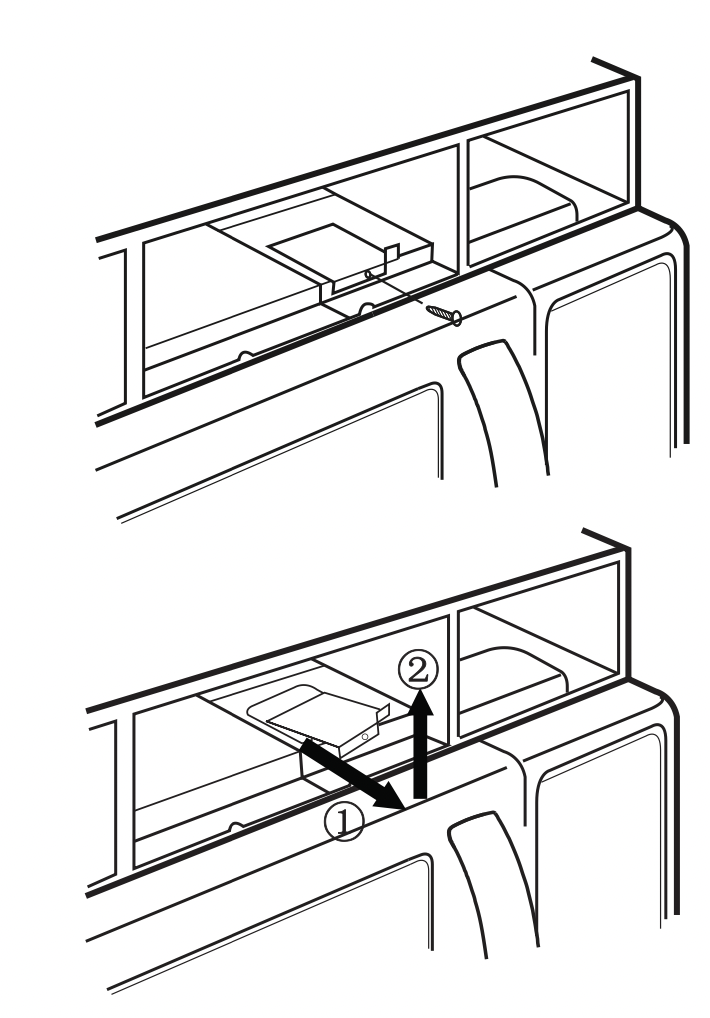
- Replace the bulb with a 30 watt appliance bulb.
- Replace the bulb holder and screw.
- Slide the top of the vent cover into place. Push the bottom until it snaps into place. Replace the mounting screws. Turn the power back on at the main power supply.
COOKING UTENSILS
MICROWAVE UTENSIL GUIDE
|
USE |
DO NOT USE |
|
OVENPROOF GLASS (treated for high intensity heat): Utility dishes, loaf dishes, pie plates, cake plates, liquid measuring cups, casseroles and bowls without metallic trim. CHINA: Bowls, cups, serving plates and platters without metallic trim. PLASTIC: Plastic wrap (as a cover)-- lay the plastic wrap loosely over the dish and press it to the sides. Vent plastic wrap by turning back one edge slightly to allow excess steam to escape. The dish should be deep enough so that the plastic wrap will not touch the food. As the food heats it may melt the plastic wrap wherever the wrap touches the food. Use plastic dishes, cups, semirigid freezer containers and plastic bags only for short cooking time. Use these with care because the plastic may soften from the heat of the food. PAPER: Paper towels, waxed paper, paper napkins and paper plates with no metallic trim or design. Look for the manufacturer's label for use in the microwave oven. |
METAL UTENSILS: Metal shields the food from microwave energy and produces uneven cooking. Also avoid metal skewers, thermometers or foil trays. Metal utensils can cause arcing, which can damage your microwave oven. METAL DECORATION: Metal-trimmed or metal-banded dinner ware, casserole dishes, etc. Themetal trim interferes with normal cooking and may damage the oven. ALUMINUM FOIL: Avoid large sheets of aluminum foil because they hinder cooking and may cause harmful arcing. Use small pieces of foil to shield poultry legs and wings. Keep ALL aluminum foil at least 1 inch from the side walls and door of the oven. WOOD: Wooden bowls and boards will dry out and may split or crack when you use them in the microwave oven. Baskets react in the same way. TIGHTLY COVERED UTENSILS: Be sure to leave openings for steam to escape from covered utensils. Pierce plastic pouches of vegetables or other food items before cooking. Tightly closed pouches could explode. BROWN PAPER: Avoid using brown paper bags. They absorb too much heat and could burn. FLAWED OR CHIPPED UTENSILS: Any utensil that is cracked, flawed or chipped may break in the oven. METAL TWIST TIES: Remove metal twist ties from plastic or paper bags. They become hot and could cause a fire. |
Do not use recycled paper products in the microwave oven. They sometimes contain impurities that cause sparks to occur.
FAQS
FREQUENTLY ASKED QUESTIONS
Q. Can I use a rack in my microwave oven so that I may reheat or cook on two levels at a time?
A. Only use the rack that is supplied with your rmicrowave oven. Use of any other rack can result in poor cooking performance and/or arcing and may damage your oven.
Q. Can I use either metal or aluminum pans in my microwave oven?
A. Usable metal includes aluminum foil for shielding (use small, flat pieces), and shallow foil trays (if tray is 3/4 inch deep and filled with food to absorb microwave energy). Never allow metal to touch walls or door.
Q. Sometimes the door of my microwave oven appears wavy. Is this normal?
A. This appearance is normal and does not affect the operation of your oven.
Q. What are the humming noises that I hear when my microwave oven is operating?
A. You hear the sound of the transformer when the magnetron tube cycles on and off.
Q. Why does the dish become hot when I microwave food in it? I thought that this should not happen.
A. As the food becomes hot it will conduct the heat to the dish. Use hot pads to remove food after cooking.
Q. What does “standing time” mean?
A. ”Standing time” means that food should be taken out of the oven and covered for additional time after cooking. This process allows the cooking to finish, saves energy and frees the oven for other purposes.
Q. Can I pop popcorn in my microwave oven? How do I get the best results?
A. Yes. Pop packaged microwave popcorn following manufacturer’s guidelines or use the preprogrammed Popcorn button.
Do not use regular paper bags. Use the “listening test” by stopping the oven as soon as the popping slows to a “pop” every one or two seconds. Do not try to repop unpopped kernels. You can also use special microwave poppers. When using a popper, be sure to follow manufacturer’s directions. Do not pop popcorn in glass utensils.
Q. Why does steam come out of the air exhaust vent?
A. Steam is normally produced during cooking. The microwave oven has been designed to vent this steam out the top vent.
TROUBLESHOOTING
BEFORE CALLING FOR SERVICE
Check the following list to be sure a service call is really necessary. A quick review of this manual as well as the additional information in this checklist may prevent an unneeded service call.
If nothing on the oven operates:
- check for a blown circuit fuse or a tripped main circuit breaker.
- check if oven is properly connected to electric circuit in house.
- check that controls are set properly.
If the oven interior light does not work:
- the light bulb is loose or defective.
If the oven will not cook:
- check that cooking program was entered correctly.
- check that door is firmly closed.
- check that Start button was pressed.
- check that probe was inserted correctly into receptacle.
- check that timer wasn't started instead of a cook function.
If oven takes longer than normal to cook or cooks too rapidly:
- be sure the Power Level is programmed properly.
If the time of day clock does not always keep correct time:
- check that the power cord is fully inserted into the outlet receptacle.
- be sure the oven is the only appliance on the electrical circuit.
If food cooks unevenly:
- be sure food is evenly shaped.
- be sure food is completely defrosted before cooking.
- check placement of aluminum foil strips used to prevent overcooking.
If food is undercooked:
- check recipe to be sure all directions (amount, time, power levels) were correctly followed.
- be sure microwave oven is on a separate circuit.
- be sure food is completely defrosted before cooking.
If food is overcooked:
- check recipe to be sure all directions (amount, power level, time, size of dish) were followed.
If arcing (sparks) occur:
- be sure microwavable dishes were used.
- be sure wire twist ties weren’t used.
- be sure oven wasn’t operated when empty.
- make sure metal rack (if used) is properly installed on supports.
If the Display shows a time counting down but the oven is not cooking:
- check that door is firmly closed.
- check that timer wasn’t started instead of a cooking function.
